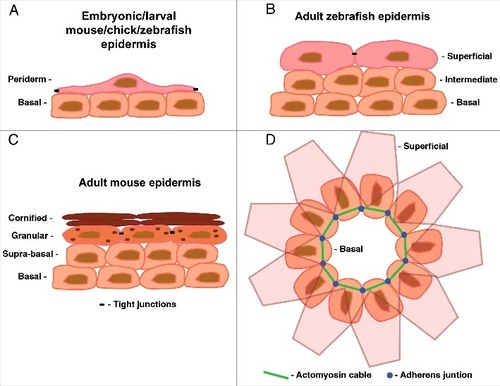Figure 1.
- ID
- ZDB-FIG-190723-2374
- Publication
- Richardson et al., 2016 - The role of Rho kinase (Rock) in re-epithelialization of adult zebrafish skin wounds
- Other Figures
- All Figure Page
- Back to All Figure Page
|
(A-C) Representations of cross sections through the epidermis at different time-points and in the different models used for wound healing studies. (A) In embryonic mice and chicks the epidermis is bilayered at the stages used for embryonic wound closure experiments (E12 in mouse, E6 in chick). At these stages the epidermis consists of an inner basal layer and an outer covering of flattened periderm cells. The epidermis of late embryonic and larval zebrafish is very similar in structure and function. (B) In adult zebrafish the epidermis becomes stratified consisting of 2 to 3 layers of basal and intermediate cells and an outer superficial layer. This resembles the epidermis of mid-gestation mice (E13-E15) and chicks (E15-E17) of corresponding developmental stages. (C) The epidermis of adult mice and chicks is also stratified consisting of 4 distinct layers: the innermost basal layer, the suprabasal layer, the granulation layer where terminal differentiation commences and the outermost cornified layer consisting of terminally differentiated cornified envelopes. (D) Representation of a dorsal view of the bilayered epidermis of an embryonic chick or mouse depicting the actomyosin cable form of wound closure. For simplicity only the LE cells of the basal epidermis are shown. The first row of superficial periderm cells are depicted as semi-translucent to allow vizualization of the basal cells beneath. |

